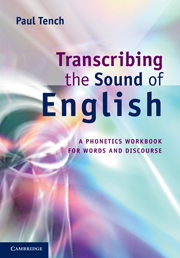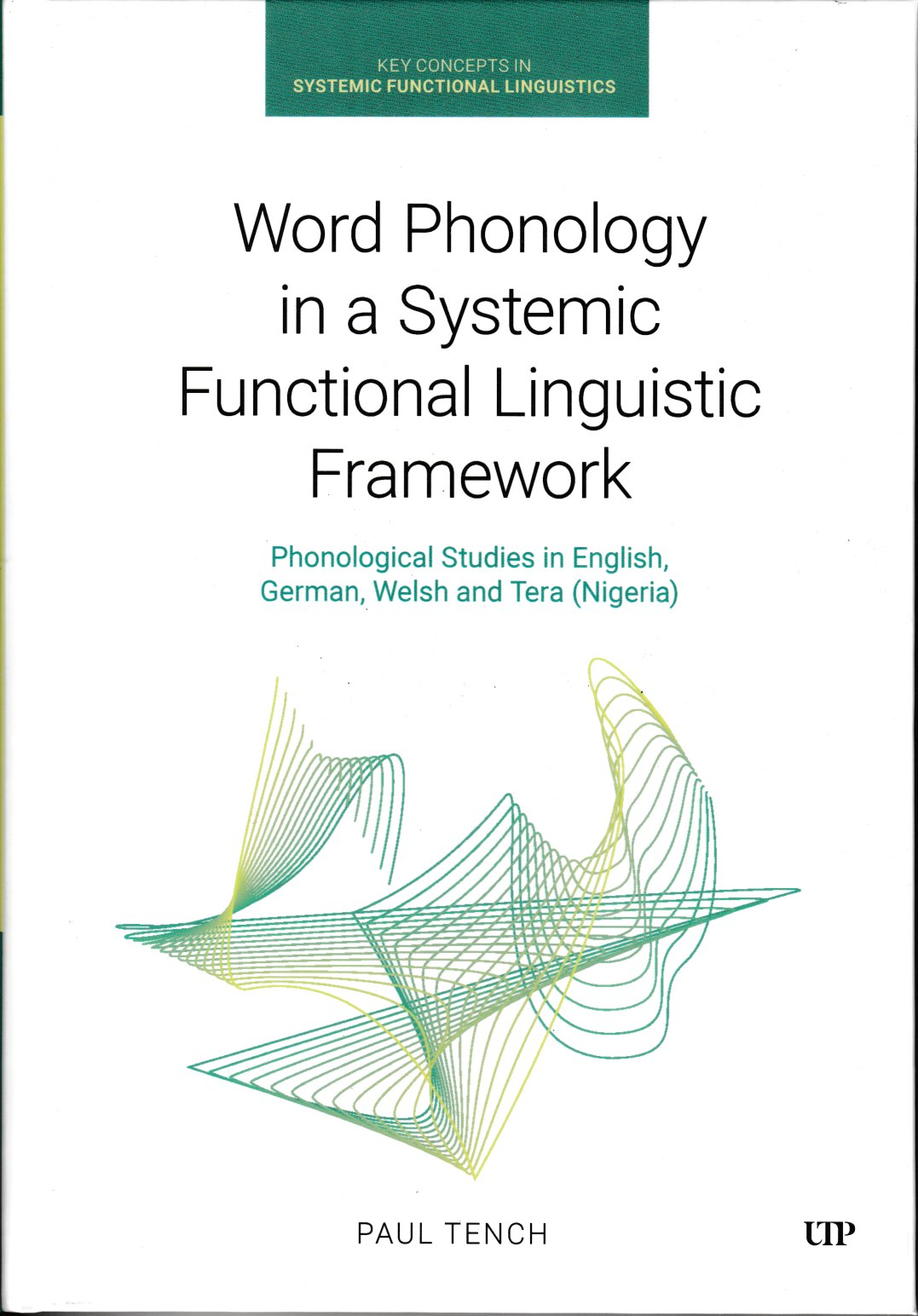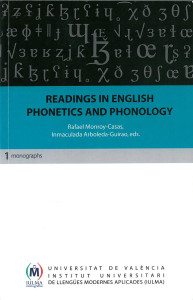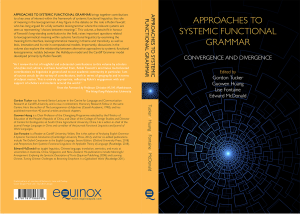Books (including monographs)
1973 Handbuch der artikulatorischen Phonetik p1-48; Seminar fur Sprachmethodik, Burbach-Holzhausen, Germany (revised 1976).
1981 Pronunciation Skills, p1-124, Macmillan, London. (ISBN: 0333 27178 5).
1985 Talent, Potential, but No Resources, Report of the Seminar on English Language Teaching in Madagascar, UWIST, Cardiff, piv-39.
1988 Specification of Intonation for Prototype Generator 2, COMMUNAL, Cardiff p1-40.
1990 The Roles of Intonation in English Discourse, pxiv-534; Peter Lang, Bern, Switzerland. (ISBN: 3-631-42654-2).
1992 Studies in Systemic Phonology (Editor) P1-265, Pinter Publishers (ISBN 086187-784-5).
1996 (with M. Ball and J. Rahilly)The Phonetic Transcription of Disordered Speech p1-203, San Diego, CA, Singular Publishing. (ISBN 1-56593-206-4, 203 pages).
1996 The Intonation Systems of English, Cassell Academic, London (ISBN: 0-304-33690-4; 0-304-33691-2) pix-160.
2011 Transcribing the sound of English: a phonetics workbook for words and discourse, Cambridge University Press, Cambridge. (ISBN 978-0-521-16605-8/978-1-107-00019-3; i-vii, 1-192; with accompanying website).
2024 Word Phonology in a Systemic Functional Linguistic Framework; phonological studies in English, German, Welsh and Tera (Nigeria), University of Toronto Press, Toronto. (ISBN 978-1-1-4875-6653-1/978-1-4875-6652-4; i-xii, 1-189)
Word Phonology in a Systemic Functional Framework
Paul Tench, Cardiff University, Wales
I have been anxious to explore the potential of Systemic Functional Linguistics (SFL) at the level of word phonology for some time. So much work has been done in SFL on grammar and discourse, and related themes, and on intonation where I have enjoyed working in the past, but nothing has been done, as far as I know, on the phonology of words. I have wanted to explore the application of principles and practices of SFL at this level of phonology to see if they work. So, in my retirement, I’ve devoted some time to this, and, lo and behold, I think they do work – not so much in meaning, but in the structure of systems and functions. What I have presented is a different kind of description of phonology, and I have applied it not only to English but I also wanted to try it out on other languages as well, to German, Welsh and a completely different, non-European language, a Chadic language spoken in the north of Nigeria, Tera.
I have used the common features of phonemes in a hierarchical setting at a superficial level – no imagining of hypothetical underlying forms, which I find to be disconcertingly debatable – but actual practical data that the mind assembles into the mental phonology of a particular language or dialect. New words are coined with this mental phonology, and words from other languages are similarly incorporated, in time. There can be different phonologies for different parts of the grammar; the phonology of pronouns as distinct from nouns, or of loan words as distinct from native words, etc. Also there are no pretensions at universalism; each language must be described in its own terms, and that is also true of its phonology. Everybody has their own mental phonology, with their own phonetic output (idiolect), but it is constrained conventionally to aid social communication. And word phonology changes in time as one generation prefers a different pronunciation from another generation (diachronic phonology).
The basic function of word phonology is to provide distinct phonic shapes for all the lexical and grammatical items in a language (although it is true that generations of speakers have produced homonyms!) and for this reason it is integral to the make-up of language. As I like to say, there is no language without phonology; even dead languages had a phonology! Two practical points: I suggest that introductions to linguistics should not begin with phonetics and phonology as a separate level of language, but should begin with words – morphologically and then phonologically; and secondly, when we do teach pronunciation, a fuller awareness of phonology would be a bonus.
I have deliberately not given any examples to illustrate my claims, as it would make this introduction too long. You will have to read the book for them! And Tera is quite different from the other languages in this presentation of phonology!
Published by University of Toronto Press; ISBN 978-1-4875-6653-1: pp xii-189
Paul Tench
Articles
1. 1976 `Double Ranks in a Phonological Hierarchy; in Jnl of Linguistics, Vol12 p1-20.
2. 1978 `On introducing parametric phonetics’, in Jnl of Intern. Phon. Ass. Vol. 8 p34-46.
3. 1978 Review: Listening to Spoken English(G. Brown, Longman, 1977), in Jnl of Intern. Phon. Ass, Vol. 8, No. 2. p83-91
4. 1980 `Aspects of Hausa intonation, 1: utterances in isolation’, in Jnl of Intern. Phon.Ass. Vol. 10, p45-63 (with J. Miller).
5. 1982 `Aspects of Hausa intonation, 2: continuous text’, in Jnl of Intern. Phon. Ass, Vol. 12 p78-93 (with J. Miller).
6. 1983 Review: Use of EnglishCourse for West African Students(H. Parry), in W.African Jnl of Education p100-107.
7. 1984 Review: English Phonetics and Phonology : A Practical Course.(P. Roach) in English Lang. Teach Jnl, vol 30, p296-298.
8. 1984 Review: English Phonemic Transcription(I. Morris-Wilson) in Jnl of Intern. Phon. Ass. Vol 14 p89-91.
9. 1985 `Teaching English as a Foreign/Second Language’ in Spectrum. Vol. 17, p42-44.
10. 1985 `The external and internal factors that contribute to linguistic errors; in W.African Jnl of Ed, Vol 20. p1-19
11. 1987 Review: An English Pronunciation Dictionary(J.B. Wynn) in IATEFL Phonology Newsletter, Vol 2 p15-17.
12. 1987 `The Teacher as Researcher‘, in Bickley, V. (ed): Language Teacher Education: Re-exploring CELT(Continuing Education for Language Teachers) Institute of Language in Education, Hong Kong, p220-230.
13. 1988 `The Stylistic Potential of Intonation‘, in Coupland, N. (ed): Styles of Discourse Croom Helm, London, p50-84. (ISBN: O-7099-4852-2).
14. 1988 `A Bilingual Methodology for Second Language Teaching’, in Bickley, V. (ed): Languages in Education in a Bi-lingual or Multi-lingual Setting, Institute of Language in Education, Hong Kong p399-419.
15. 1988 Review: Simple Phonetics for Teachers(J. Smith & M. Bloor, Methuen, London, 1985), in Jnl of Intern. Phon. Ass, Vol. 18 p.158-160
16. 1989` Representing Pronunciation in the COBUILD Dictionary’, in Speak Out, IATEFL Phonology SIG, 4 p18-22.
17. 1989 `A Welcome Development in the Training of English Teachers’, in SPELT Newsletter VI(3) Karachi, Pakistan p14-21.
18. 1990 `The Pronunciation of English in Abercrave’, in Coupland, N. (ed): English in Wales, Multilingual Matters, Clevedon, p.130-141. (ISBN: 1-85359-032-0)
19. 1990 Review: Longman Pronunciation Dictionary(J.C. Wells, Longman, London, 1990) in Practical English Teaching Vol. 11, No. 1 p. 79-80.
20. 1990 `The Roles of Intonation in English Discourse’ in IATEFL Newsletter, No.108, p.26.
21. 1991 Review: Sounds English(J.D. 0’Connor & C. Fletcher, Longman, London, 1989) in ELT Journal Vol. 45/3, p. 275-7.
22. 1991 `Some Remarks on Halliday’s Description of British English Intonation’, in Network 17 p76-84.
23. 1991 Review: Intonation and its Uses : Melody in Grammar and Discourse (D. Bolinger, Edward Arnold, London 1989), in Network 17, p93-98.
24. 1991 `Learning about English Intonation’, in IATEFL Newsletter, No. 112, p.26.
25. 1992 `From Prosodic Analysis to Systemic Phonology’, in P.Tench: Studies in Systemic Phonology 1992, p1-18.
26. 1992 `Tone and the Status of Information’, in P. Tench: Studies in System Phonology 1992, p161-174.
27. 1992 (with D. Eddaikra) `The Pharyngealization System in Algerian Spoken Arabic, in P.Tench : Studies in Systemic Phonology 1992, p77-86.
28. 1992 Phonetic Symbols in the Dictionary and in the Classroom, Approaches to Pronunciation Teaching (Editor Adam Brown), Modern English Publications in association with the British Council, Macmillan, London, P.90-102 ISBN 0-333-58246-2.
29. 1993 Teaching English /l/ and /r/, Speak Out! (IATEFL) No. 12 p.9-11.
30. 1993 English Intonation and Grammar, IATEFL Annual Conference Report, 1993 p.23.
31. 1994 Review: An Introduction to Phonology (F. Katamba, Longman, Harlow 1989
ISBN 0582 29150X) in Word, 45:2, p181-186.
32. 1994 `The Boundaries of intonation units’, in J.W. Lewis (ed) Studies in General and English Phonetics : In Honour of Professor J.D. 0’Connor, Routledge, London, p270-277. ISBN 0 415 080681.
33. 1995 Review: Phonological Investigations (J. Fisiak & S. Puppel, John Benjamins, Amsterdam, 1992), in Word 46:2, p293-296.
34. 1995 Review: Homage to W.R.Lee : Essays in English as a Foreign or Second Language (ed. A. van Essen & E. Burkart, Foris, Berlin, 1992), in Word 46:2, p296-299.
35. 1995 `The Emergence of a New Tone in English Intonation’, in IATEFL Annual Conference Report, 1995, p8-9.
36. 1995 `A bilingual methodology for second language teaching’ (see no. 14) reprinted in Immersion Language Teaching: Selected Readings 1, Distance Education Centre, University of Southern Queensland, Australia.
37. 1996 `The Communicative Value of the tone system of English’ in Proceedings of the 9th International Symposium on Theoretical and Applied Linguistics, Aristotle University, Thessaloniki, 1995; p149-165 ISBN 960-243-114-8.
38. 1996`A New Tone – Routine Listing’, in Speak Out (IATEFL), No. 18 Summer 1996, p26-32. ISSN 1026 4345. With cassette.
39. 1996 `Methodology in Phonological Interlanguage’, in International Review of Applied Linguistics, XXXLX: 4, 241-60 ISSN 0019-042X
40. 1996 ‘Intonation and the Differentiation of Syntactical Patterns in English and German’, in International Journal of Applied Linguistics, 6: 2, 223-56 ISSN 0802-6106
41. 1997 ‘The Fall and Rise of the Level Tone in English’, in Functions of Language 4:1, 1-22 ISSN 0929-998X
42. 1997 Review: English Speech Rhythm; Form and Function in Everyday Verbal Interaction (Couper-Kuhlen, E ; Amsterdam:Benjamins,1993) in Functions of Language 4:1, 119-24 ISSN 0929-998X
43. 1997 Review: Describing Spoken English: an Introduction (Kreidler, C W: London/New York: Routledge, 1997) in Functions of Language 4:1, 310-2 ISSN 0929-998X
44. 1997 ‘Towards a design of a pronunciation test’, in Speak Out! 20: 29-43 ISSN 1026-4345
45. 1997 Review: English Pronouncing Dictionary, 15th Ed(Daniel Jones, ed Roach,P& Hartman, J; Cambridge: CUP, 1997), in Speak Out! 21:44-8 ISSN 1026-4345
46. 1997 ‘Intonation innovations’, in IATEFL Newsletter 140: 17-8 ISSN 0257-6554
47. 1997 Review: Prosody in Conversation: Interactional Studies (Couper-Kuhlen, E & Selting, M; Cambridge: CUP 1996) in Journal of Sociolinguistics 1:2: 290-3 ISSN 1360-6441
48. 1998 ‘RIP: RP?’, in Journal of Sociolinguistics 2:1, 107-9 ISSN 1360-6441
49. 1998 Review: Phonology in English Language Teaching (M C Pennington, Longman 1996), in Journal of Sociolinguistics 2:2, 312-4 ISSN 1360-6441
50. 1998 ‘Phonological Universals and the Pronunciation of English’, in IATEFL 1998 , Whitstable: IATEFL pp19-20 ISBN 1 901095 55X
51. 1999 ‘A sound experiment? An attempt to evaluate alternative strategies’, in Speak Out! 23: 5-14 ISSN 1026-4345
52. 1999 Book notice: Intonation (2nd edition; Cruttenden, A; Cambridge: CUP 1997) in Journal of Sociolinguistics 3:3, 415 ISSN 1360-6441
53. 2000 Review: Accent in Context (Chapman, S; Bern:PeterLang, 1998) in English Language and Linguistics, 4:2,333-5 ISSN 1360-6743
54. 2001 ‘English Pronunciation at the Turn of the Millennium’, in Speak Out! 27: 43-7 ISSN: 1026-4345
55. 2001 ‘What grammar is actually for’, in Subject Centre Grammar Supplement, Liaison, Issue 3: 17-9 ISSN: 1472-6432
56. 2001 ‘An Applied Interlanguage Experiment into Phonological Misperceptions of Adult Learners’, in International Journal of English Studies 1:1: 259-276 ISSN: 1578-7044
57. 2001 ‘What we actually need grammar for: an introduction to a functional perspective on grammar’, in Journal of Research, BZ Univerity, Multan, Pakistan: 1-18
58. 2003 ‘Non-native speakers’ misperceptions of English vowels and consonants: evidence from Korean adults in UK’, in International Review of Applied Linguistics, 41: 145-173 ISSN: 041-0145
59. 2003 ‘English pronunciation of the Unmarked Young, a review of Upton et al Oxford Dictionary of Pronunciation’, in Speak Out! :30 : 21-25 ISSN: 1026-4345
60. 2003 Review: Roach, P (2001) Phonetics Oxford: OUP, in System 31: 426-428 ISSN: 0346-251X
61. 2003 ‘Processes of semogenesis in English intonation’ in Functions of Language 10:2:209-234 ISSN: 0929-998X
62. 2004 ‘EPD16. A review of the Cambridge English Pronouncing Dictionary, 16th edition, CUP 2003’, in Speak Out!, 31: 33-37 ISSN: 1026-4345
63. 2005 ‘Talking intonation’, in Speak Out! 34: 3-15 ISSN: 1026-4345
64. 2005 ‘Teaching intonation’, in Speak Out! 34: 45-53 ISSN: 1026-4345
65. 2006 ‘Two practical tasks in intonation analysis’ in Speak Out! 35: 40-43 ISSN:1026-4345
66. 2007 Illustrations of the IPA: Tera Journal of the International Phonetic Association 37:2: 227-234
67. 2007 Review: Gussenhoven, C The phonology of tone and intonation. Cambridge: Cambridge University Press 2004, xxiv+355, and Wells, J C English intonation; an introduction. Cambridge: Cambridge University Press 2006, ix+276. in Functions of Language 14/2: 261-277
68. 2008 ‘Spelling in the Mind: phonemic-graphemic correspondence hypotheses’. In Edwardes M (ed) ‘Proceedings of the BAAL Annual Conference 2007’. Scitsiugnil Press: London.(ISBN: 978-0-9559533-0-9), p 121-130 (with Rhiannon Vaughn Griffiths and Ben Clarke)
69. 2008 Reading and Writing Tera (Nyimatli), p 1-42. Nyimatli Language Project: Gombe, Nigeria. (with the Nyamtli/Tera Group, Gombe, Nigeria)
70. 2008 Reading and Writing Ngizim, p 1-32. Bama, Adamawa, Nigeria: Seed Company
71. 2008 Review: Halliday & Greaves Intonation in the Grammar of English. Functions of Language 17.2; 255-265
72. 2009 The Pronunciation of Grammar. Plenary address, 3rdInternational Congress on English Grammar. Salem, TN, India: Sona College of Technology. ISBN:978-81-906270-0-9
73. 2009 Towards a Description of Tamil English Standard Pronunciation. Salem, TN, India: Sona College of Technology. ISBN: 978-81-906270-0-9
74. 2010 ‘The Pronunciation of Grammar’, Sonalesa (India), July 2010. 1-11 (ISSN: 0974-147X)
75. 2011 Reading and Writing ciShanjo, p 1-27. Mongu, Zambia: Seed Company
76. 2011 Reading and Writing Glvaghda, p 1-26. Gavva, Borno, Nigeria: Seed Company
77. 2012 Reading and Writing Etkwen (Ichen), p 1-28. Zing, Taraba, Nigeria: Seed Company
78. 2014 ‘A systemic functional model of the intonation of clauses in English’ , in Monroy-Caes, R & Arboleda-Guirau, I (eds) Readings in English Phonetics and Phonology. Universitat de València, Spain, p 261-296. 978-84-370-9455-7.
79. 2014 ‘Towards a systemic presentation of the word phonology of English’, in Bowcher, W L & Smith, B A (eds) Systemic phonology. Recent studies in English. Sheffield: Equinox, p 267-294. 978-1-84553-946-7.
80. 2014 Writing and Reading Boi (TiYaa), p 1-27. Jos, Plateau, Nigeria: Seed Company
81. 2017 ‘The phoneme and word phonology in systemic functional linguistics’, in Bartlett, T & O’Grady, G (eds) The Routledge Handbook of Systemic Functional Linguistics. London: Routledge
82. 2018 ‘Dodson’s classroom experiments in pronunciation’, Journal of Second Language Pronunciation 4:1 , p 154-157
83. 2019 ‘A Life in Phonology’, Ideas IV: 4, pp 1-18 ISSN:2469-1178
84. 2020 Review: TRACEY M. DERWING & MURRAY J. MUNRO, Pronunciation fundamentals: Evidence-based perspectives for L2 teaching and research (Language Learning & Language Teaching 42). Amsterdam: John Benjamins, 2015. In Journal of the International Phonetic Association 50:1, p 141-144.
85. 2020 ‘Intonation in Semantic System Networks’, in Tucker, G, Huang, G, Fontaine, L & McDonald, E (eds) Approaches to Systemic Functional Grammar: convergence and divergence. Sheffield: Equinox
86. 2022 ‘Some reflections on Applied Linguistics studies in Wales since the 1960s’, in BAAL News, Issue 120; p 7-8.
87. Forthcoming ‘The phoneme and word phonology in systemic functional linguistics’, in Bartlett, T & O’Grady, G (eds) The Routledge Handbook of Systemic Functional Linguistics. 2nd Ed. London: Routledge



